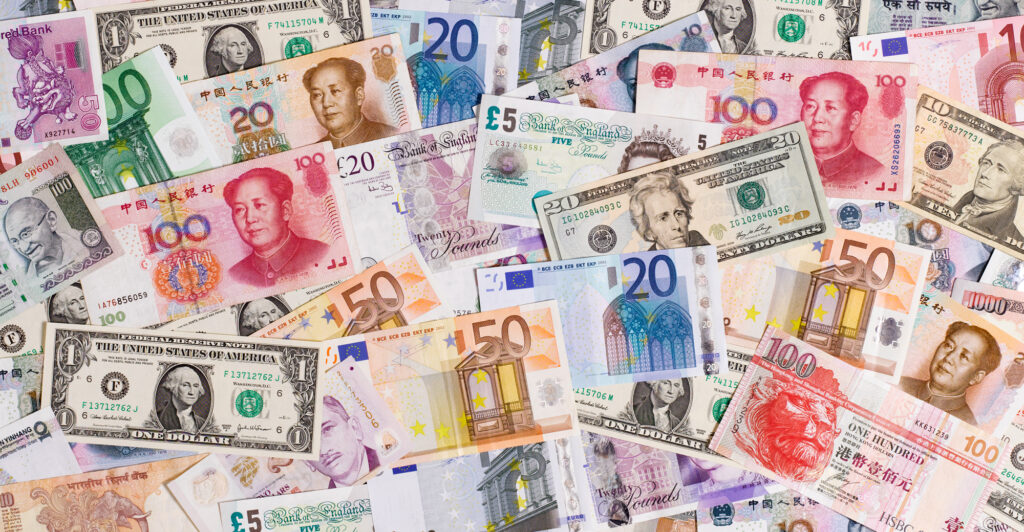banknotes used in 20 countries: Banknotes serve as the primary form of currency for transactions in almost every country. Each nation has its own unique banknotes that reflect its culture, history, and economic standing. In this article, we will explore the banknotes used in 20 countries, highlighting their currencies, designs, and significance.

1. United States – Dollar (USD)
The U.S. dollar is one of the most widely used currencies globally. Its banknotes come in denominations ranging from $1 to $100, featuring iconic figures such as George Washington and Abraham Lincoln.
2. United Kingdom – Pound Sterling (GBP)
The British pound is one of the oldest currencies still in use. UK banknotes showcase important historical figures like Queen Elizabeth II and Sir Winston Churchill.
3. European Union – Euro (EUR)
The Euro is the official currency of 19 of the 27 European Union member states. Euro banknotes feature bridges and windows to symbolize openness and cooperation.
4. Japan – Yen (JPY)
Japanese yen banknotes are known for their intricate designs and advanced anti-counterfeiting features. They depict important historical figures such as Yukichi Fukuzawa and Hideyo Noguchi.
5. Canada – Canadian Dollar (CAD)
Canada’s colorful banknotes depict both national symbols and prominent leaders. The $5 to $100 notes showcase figures like Sir Wilfrid Laurier and Viola Desmond.
6. Australia – Australian Dollar (AUD)
Australia’s polymer banknotes are among the most secure in the world. Featuring figures like David Unaipon and Edith Cowan, they highlight the country’s cultural diversity.
7. China – Renminbi (CNY)
China’s banknotes, commonly referred to as yuan, feature Mao Zedong on the front and depict historical landmarks such as the Great Hall of the People.
8. India – Indian Rupee (INR)
India’s rupee notes have gone through numerous changes. The latest series features Mahatma Gandhi on the front and various heritage sites on the reverse.
9. Russia – Russian Ruble (RUB)
Russian ruble banknotes reflect the country’s vast cultural and geographical diversity. Each denomination highlights a different Russian city or monument.
10. Mexico – Mexican Peso (MXN)
Mexico’s banknotes depict prominent historical figures like Benito Juárez and Frida Kahlo, showcasing the country’s rich cultural history.
11. Brazil – Brazilian Real (BRL)
Brazilian banknotes feature colorful wildlife on the reverse side and significant national symbols on the front, with figures like Pedro Álvares Cabral.
12. South Africa – South African Rand (ZAR)
South African banknotes feature Nelson Mandela alongside the country’s famed Big Five wildlife species, highlighting its natural beauty.
13. Saudi Arabia – Saudi Riyal (SAR)
The Saudi riyal includes images of the nation’s founding figures and religious landmarks, reflecting its deep-rooted Islamic culture.
14. Argentina – Argentine Peso (ARS)
Argentine peso banknotes highlight the country’s natural beauty and historical figures, such as José de San Martín and Eva Perón.
15. Switzerland – Swiss Franc (CHF)
Swiss banknotes are recognized for their artistic designs and security features. The CHF features influential Swiss figures like Le Corbusier.
16. Sweden – Swedish Krona (SEK)
Swedish krona banknotes highlight Swedish cultural and scientific contributions, showcasing personalities such as Greta Garbo and Ingmar Bergman.
17. Norway – Norwegian Krone (NOK)
Norwegian krone banknotes feature designs inspired by the country’s maritime history and the natural beauty of its fjords and coastlines.
18. Turkey – Turkish Lira (TRY)
The Turkish lira banknotes depict Mustafa Kemal Atatürk, the founder of modern Turkey, on every note, alongside various national landmarks.
19. South Korea – South Korean Won (KRW)
South Korean won banknotes highlight important cultural and historical figures, such as King Sejong the Great and Admiral Yi Sun-sin.
20. Singapore – Singapore Dollar (SGD)
Singapore’s dollar notes feature its first president, Yusof bin Ishak, along with landmarks representing the nation’s progress and modernity.
Conclusion
Banknotes used in 20 countries reflect more than just currency; they represent national pride, history, and cultural identity. From the intricate designs of the Japanese yen to the vibrant colors of the Canadian dollar, each nation’s currency tells a unique story.
Understanding these global currencies provides insight into the diverse cultural and historical fabric of the world.
